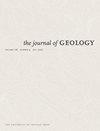早白垩世黑色页岩蚀变化学指标的时间变化与古气候的关系
IF 1.3
4区 地球科学
Q2 GEOLOGY
引用次数: 1
摘要
为了更好地了解东亚内陆早白垩世的气候变化,从中国东部灵山岛下白垩统莱阳群法家营组露头的黑色页岩中重建了蚀变化学指数的时间变化。随着地层高度的增加,相应的CIA增加。所获得的成分变异值指数和(Al2O3)–(CaO*+Na2O)–K2O三元图表明,采集的样品在成岩过程中没有演变成钾交代作用。此外,在Th/Sc与Zr/Sc图中,与岩浆趋势平行的低Zr浓度表明沉积物分选和再循环不会影响古风化指标。CIA与Al/Si或K/Si之间缺乏相关性,这进一步表明古风化指标不受沉积物分选的影响。因此,随着CIA和风化化学指数的增加,相应的化学风化略有增加。这与Rb/Sr、Sr/Cu、Al2O3/MgO和粘土矿物等古气候指标提出的从干热气候向暖湿气候的转变一致。在这项研究中,提出了古气候变化与页岩CIA之间几乎普遍存在的相关性,其中湿度的增加显著增加了化学风化。同时,研究发现,在早白垩世的干热条件下,远离海洋的内陆地区的化学风化相对较弱,并依赖于大气湿度。该分析验证了CIA作为地层记录的一部分,是白垩纪早期陆地古气候变化的有力代表。本文章由计算机程序翻译,如有差异,请以英文原文为准。
Temporal Variation in the Chemical Index of Alteration in Early Cretaceous Black Shale as a Proxy for Paleoclimate
To better understand Early Cretaceous climate variation in inland East Asia, the temporal variation in the chemical index of alteration (CIA) was reconstructed in black shale from an outcrop of the Fajiaying Formation in the Lower Cretaceous Laiyang Group at Lingshan Island, East China. As the formation height increased, the corresponding CIA increased. The obtained index of compositional variability values and an (Al2O3)–(CaO* + Na2O)–K2O ternary diagram demonstrate that the gathered samples had not evolved into K-metasomatism during diagenesis. Moreover, low Zr concentrations parallel to the magmatic trend in the Th/Sc-versus-Zr/Sc diagram reveal that the sediment sorting and recycling did not affect the paleoweathering proxies. The lack of correlation between the CIA and Al/Si or K/Si further suggests that the paleoweathering proxies were not affected by the sediment sorting. Accordingly, as the CIA and the chemical index of weathering increased, the corresponding chemical weathering increased slightly. This is consistent with the transition from a dry-hot climate to a warm-humid one proposed by paleoclimatic proxies such as Rb/Sr, Sr/Cu, Al2O3/MgO, and clay minerals. In this study, a near-ubiquitous correlation is proposed between the variations of paleoclimate and the CIA of shale, in which a rise in humidity significantly increased the chemical weathering. Meanwhile, it was found that under the dry-hot conditions of the Early Cretaceous, chemical weathering in inland areas far from the ocean was relatively weak and dependent on atmospheric humidity. This analysis validates the CIA, as part of the stratigraphic record, to be a robust proxy for terrestrial paleoclimatic variation during the Early Cretaceous.
求助全文
通过发布文献求助,成功后即可免费获取论文全文。
去求助
来源期刊

Journal of Geology
地学-地质学
CiteScore
3.50
自引率
5.60%
发文量
0
审稿时长
3 months
期刊介绍:
One of the oldest journals in geology, The Journal of Geology has since 1893 promoted the systematic philosophical and fundamental study of geology.
The Journal publishes original research across a broad range of subfields in geology, including geophysics, geochemistry, sedimentology, geomorphology, petrology, plate tectonics, volcanology, structural geology, mineralogy, and planetary sciences. Many of its articles have wide appeal for geologists, present research of topical relevance, and offer new geological insights through the application of innovative approaches and methods.
 求助内容:
求助内容: 应助结果提醒方式:
应助结果提醒方式:


